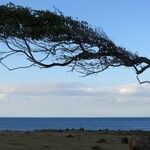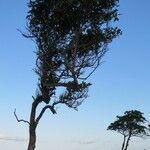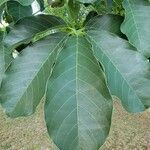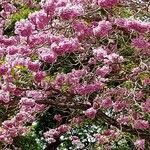mediate petiolules 1.5-9.5 cm long, lateral petiolules 0.2-2.4 cm long, the petiole 5-32 cm long, lepidote. Inflorescence a terminal panicle with a pair of subulate bracts subtending each dichotomy, the branches densely lepidote. Flowers slightly sweet-smelling, calyx cupular, bilabiate, 11-21 cm long and 6-12 cm wide, densely lepidote; corolla white to pinkish-lavender or magenta, the throat opening yellow, turning white, tubular-infundibuliform, 5-10 cm long and 1.5-3.2 cm wide at the mouth of tube, the tube 3-5.8 cm long, the lobes 2.2-2.6 cm long, glabrous outside, ciliate, sparsely pubescent within with small mostly unicellular trichomes on throat ridges and gland-tipped trichomes at the point of stamen insertion; stamens didynamous, the thecae divaricate, 2.5-3.5 mm long, the longer filaments 1.4-2.0 cm long, shorter filaments 1.0-1.5 cm long, the staminode 2-6 mm long, inserted 5-10 mm from base of corolla; pistil 1.9-3.2 cm long, the ovary linear, 5-8 mm long and 1 mm wide, densely lepidote, the ovules 2-seriate in each locule; disc tapered-cupular, 2-3 mm long and 3-3.5 mm wide. Capsule linear-cylindric, attenuate at both ends, 22-38 cm long and 0.9-1.5 cm wide, lepidote, the calyx usually persistent; seeds 0.7-1.0 cm long and 2.84.4 cm wide, the wings hyaline-membranaceous, sharply de-marcated from the seed body.
More
Tree to 25 or 30 m tall and 1 m d.b.h., the bark narrowly vertically fissured with corky ridges, dark gray to blackish; wood superficially similar to oak, of medium density, light grayish brown with distinct pattern from stripings of brown paratracheal parenchyma, when fresh with faint sweet odor suggesting watermelon; twigs subtetragonal, lepidote, with thick pith, the nodes without interpetiolar glands or pseudostipules. Leaves palmately 5-foliolate, often aniso-phyllous; the leaflets elliptic to elliptic-oblong, acute to acuminate, basally rounded to cuneate, the terminal leaflet 8-35 cm long and 3-18 cm wide, the intermediate pair 6-34 cm long and 3-17 cm wide, the lateral pair 3.5-25 cm long and 1.4-12 cm wide, entire, subcoriaceous to chartaceous, lepidote above and beneath, gray-green when dry; the terminal petiolule 2-11 cm long, inter-
A large tree. The bark is grey and has furrows. The leaves are compound with leaflets spread like fingers on hand. There are 5 leaflets. The flowers are pink. They are produced before the leaves.
It is a tropical plant. It grows in wet, moist and dry forests. It grows from sea level to 1,200 m above sea level. It grows in areas with a temperature range between 20°-30° C. It grows in areas with a rainfall above 500 mm.
More
Common in moist or rather dry forest, often in open fields or along roadsides, most abundant on the Pacific plains, but often on steep hillsides, at elevations up to 1,200 metres in Guatemala. Coastal thickets in Dominica.











